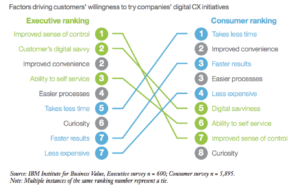1. Design digital experiences around the customer needs, not around your customer mythology
Despite mountains of data customer insight remains an elusive animal. As a direct consequence, digital is frequently applied across existing processes without fully understanding customer pain points and the real Successful Customer Outcome.
Making invalid assumptions can irritate and permanently drive customers away. Take grocery checkout for example where retailers digitize an existing experience based on assumptions of customers wants. The resulting experience may still be fractured, with faulty scanners (they break a lot), long lines, and the more than necessary Associates to provide support for glitches. Not a great customer experience. If, however you develop an understanding of customer needs (even when customers do not know them) you may discover the checkout process is not required at all. Eradicating that process meets customer’s desires in terms of speed, convenience, and simplicity.
Amazons (i) checkout-less retail stores, walk in walk out enabled by scanning your phone on entry, scanning goods as you move around the store, and then scanning your phone on departure with automatic billing, provides just such an experience. In addition to improving the experience, costs are reduced and the customers come back for more and thereby grow revenues. In fact, this triple-crown benefit is a sure fire way of measuring any customer experience transformation.
2. Drive digital initiatives to simplify and improve convenience
Customer Research demonstrates the disconnect between what executives think customers value in digital, compared to working out their needs in a more objective and structured way. A technique such as the Successful Customer Outcome Canvas (SCOC)(ii) provides a step by step approach to articulating actual needs and aligning the experiences to deliver them. The resulting insight in terms of a set of objective measures based on needs allows the organization to question every interaction in the context of ‘does this contribute to the SCO?’ and if not, how do we remove it?

Uber(iii) are a terrific example of ‘one click simple’ with the apps user interface designed around understanding the overall Successful Customer Outcome and then delivering an optimum number of interactions. Providing this digital experience helps meet the customer’s desire to move efficiently, pay digitally, and provide feedback in the moment. Part of that ‘Successful Customer Outcome Canvas’ insight was in removing the anxiety of where is the car and how long do I wait? You can see the car and driver speeding towards you on the app.
3. Categorize your customers by need, rather than segmenting by circumstance.
Dealing with customers as segments (age, income, zip code etc.) misses the vital personalisation that digital excels at. By force fitting customers into standardized processes suited to segments creates friction and fractured experiences. Diagnosing objective needs may, for instance, highlight the digital savviness (or not) of a category of customer, and in doing so allow you to create a bespoke experience. Rather than industrial age segmentation, organizations that adopt Outside-In(iv) categorization meet and evolve customer expectations in an informed way with greater empathy and the resulting trust that “you have my back”.
Are you ready? Ask yourself these questions (be honest and not complacent!)
a. Are digital initiatives aligned to Successful Customer Outcomes with optimized touch points, or are they designed around internal functional considerations?
b. Is your approach to innovation Outside-In and not restricted to departments, internal specialisms, legacy systems, regulations and last century mindsets?
c. Are you tapping in-the-moment real-time analytics to understand what your customers are experiencing as it happens, and then course correcting those experiences as they occur?
d. How are you managing your customer’s digital expectations? Are you keeping them informed of developing digital services?
e. What mechanism are you using to incorporate new digital learnings into the customer experiences? And are those learnings (next practices) gathered from outside of your sector, or are they just industry best practices?
References
i. http://bit.ly/goCX2017
ii. http://bit.ly/SCOC2017
iii. http://bit.ly/Uber2017
iv. http://bit.ly/SteveTowers2017
